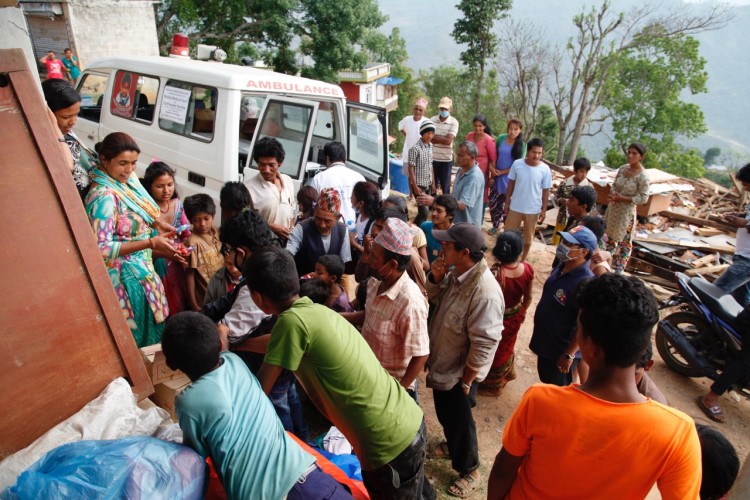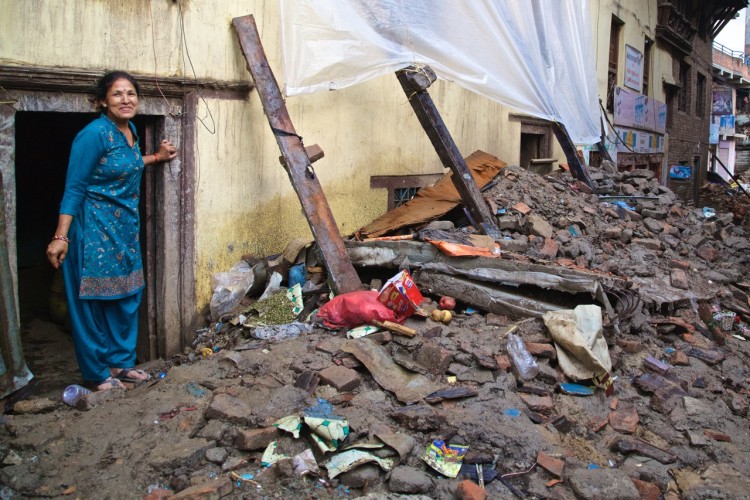Destruction in Nepal
Grandmother and granddaughter still at a loss over where to begin two weeks after the April 25 earthquake in Nepal.
I have seen the havoc wreaked by natural disasters on TV and in photos before, but I can tell you that it is entirely something else to see it in person. I came to Nepal over a month ago to climb a mountain, and am leaving with images of total human misery and loss burned into my memory.
Kathmandu - the sort-of good news
Ralf and I got back to Kathmandu last Wednesday and were happy to see that life is returning to a semblance of normal for most people. Most of the buildings we have seen in the city appear to be okay. Before coming, we were hearing stories about complete devastation, cholera and other diseases that follow when thousands of people die. It isn't like that. For the most part, life in Kathmandu doesn't feel all that different than it did when we were here a month ago, except that it is much, much quieter. Don't get me wrong - there is damage from the earthquake. Many older brick buildings were destroyed or became uninhabitable. Some people are still living in tents. Many people were killed or injured in various parts of this city of 2.5 million. For the most part, though, life in Kathmandu is carrying on.
Fortunately, we’ve witnessed very few scenes such as this one in Kathmandu.
One of the biggest problems for the city now is the lack of people filling the streets and stores. Foreign tourists numbers are down, and apparently 500,000 Nepali people left the city to return to their villages. The streets are noticeably quiet. Businesses are hurting. The beautiful Nepali people are as kind and friendly as ever - I encourage you to come and see them!
Despite all of their losses, the Nepali people still have smiles for everyone. The other night, Ralf and I got caught out in a heavy thunderstorm. A friendly Nepali family invited us into their home to wait it out, even though the majority of their village had been destroyed.
Durbar Square
Tragically, Kathmandu's historic Durbar Square with its ancient Hindu temples and palaces was almost completely destroyed. When we were here one month ago, the square was spectacular and it was a hive of activity. It is so sad to see it now. Two weeks after the earthquake, locals and tourists alike are still looking around in somber disbelief.
Note the text on top of the green sign: “Welcome to World Heritage Site”.
The brick steps were the foundation of multi-storey beautiful and ancient wooden Hindu temples.
Sindhupalchok
Nepal is divided into several regions, of which Sindhupalchok is one. It is a 2,500 square kilometre area east of Kathmandu consisting of steep forested and terraced terrain. It contains dozens of remote villages with populations of between 200 and 6,000, totalling about 60,000 people. Ralf sponsored two schools in Sindhupalchok in 2001 (300 students) and 2009 (600+ students). He heard they were damaged in the earthquake and he wanted to see the extent of the damage for himself. We were offered the unique opportunity of travelling to the villages with a medical team. I will never forget what we saw.
About 85% of the homes were flattened in each of the countless villages we drove through. All possessions were buried under rubble - food, kitchen supplies, clothing, furniture, mattresses, tools, etc. Two weeks ago, the people ran from their homes with the clothes on their backs and that is all they have now. A few lucky people have tarps or sheets of tin roofing to sleep under.
Ralf and I came back to Nepal thinking we could help in some small way, but these people need bulldozers and cement foundations and furniture. They need endless truckloads of supplies. They need the large scale support that armies provide. We felt very small, useless and helpless. We weren't really able to provide assistance to the medical team. We decided that the best thing we can do is to spread the word as far as we can get it. Financial support is desperately needed. As of May 8, the UN had only received $22 million of the estimated $400+ million needed.
The village of Thulosirubari.
I felt destroyed as we drove the three hours back to Kathmandu. We passed through village after village, all reduced to rubble. Ralf and I were heading back to clean sheets and a hot shower, and we saw the villagers sitting on the piles of bricks that used to be their homes, settling in for what must have been another night of hell. Incredibly, all of the people we interacted with still smiled and gave a heartfelt "Namaste".
As for the schools that Ralf sponsored, the rumours were partly true. His 2001 school was intact. But 95% of the homes in the village were destroyed.
The school that Ralf sponsored in 2001 is pretty much the only building left intact in the village of Irkhu. It is in a lovely location on top of the hill.
Ralf with a current and past student of the Irkhu school. The 21-year old man on the right spoke excellent English – surprising for a someone living in such a remote village. Good school!
The 2009 school sponsored by Gerlinde Kaltenbrunner and Ralf Dujmovits is a ruin. It was three storeys high, but the first floor collapsed. It needs to be demolished and rebuilt from scratch.
This school in Thulosirubari held 600-700 children. Some of them walked incredible distances from even more remote villages.
Everyone is incredibly thankful that the worst earthquake happened on a Saturday - thousands of children could have been killed and injured had it taken place during the week. It was also fortunate that it happened during the day and most people were outside of their homes.
Kids with their new “homes” behind.
A helping hand
The six doctors and three nurses we travelled with saw more than 300 patients. Two others, representing an organization called Nepalhilfe Beilingries, handed out hygiene supplies. Over the years, Nepalhilfe has raised money to build over two dozen schools, a hospital, an orphanage and they have given a lot of assistance in times of crisis. I've now seen some of the work they've done, and can easily recommend them as a good charity to give to.
Sankhu
Yesterday, we rode bikes to the village of Sankhu, just outside of Kathmandu. It looked like it would have been a really pretty village to visit before the earthquake. The devastation there was overwhelming.
They don’t have a shortage of man-power. The people simply don’t know what to do or how to start. Their tools are buried. They only have flip-flops, bare feet and bare hands.
Even here, in a village that is very easy to get to by road, we saw very little aid. There were a few Nepali police with shovels and pick-axes and a single aid tent from the Chinese Red Cross. One man told me the Canadian army was working in the area with a bulldozer, but we did not see them or any work they had done.
We passed about a dozen of these Nepali police in Sankhu. We have not seen any other organized group performing manual labour since we’ve been back, two weeks after the earthquake.
And still, a smile.
Recovery will need our help
All I have left to say is... please give generously. These lovely mountain people will never be able to recover without help from the rest of the world. There are many organizations to give to — do your research online and find a reputable one.
In Bhaktapur, Nepal.
Me, feeling small and helpless. Photo by Ralf Dujmovits.



















